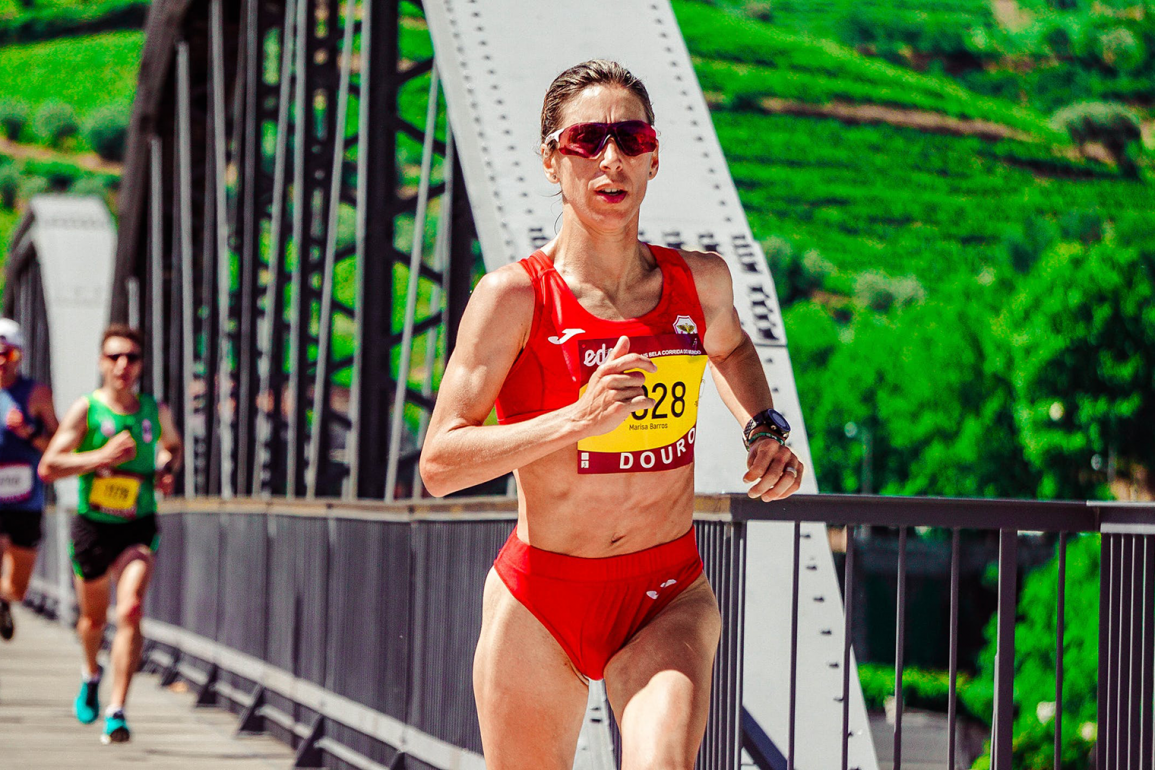Speed is both relative and concrete. It’s both an exact measure and a feeling with wholly different meanings depending on the context.
Guest Author: Sam Robinson
Originally published on HVMN
Speed is inexorably linked to time, but fast is also a feeling, one that maybe can’t be associated with time for all athletes. It can be easy to forget the idea of being fast, the heavy breathing, wind-through-your-hair, quad-burning sensation in which runners know they are hitting the ground but feel as if they’re floating.
Keeping pace with the world’s fastest runners
During the 100m dash at the 2009 Berlin World Championships, sprinter Usain Bolt hit 44.7 kph. Marathoner Eliud Kipchoge smashed the world record on September 16, 2018 (also at Berlin) with a time of 2:01:39. These runners exhibit different kinds of speed. While Bolt hit a top speed of nearly 45 kph, Kipchoge maintained 21 kph during his world-record setting marathon – that’s faster than the max speed of the average treadmill. These two extremes – sprints and marathons – are almost entirely different sports and ways to exhibit speed.
Between these two efforts, middle distance running (800m, most commonly) provides a unique physiological middle ground.
One study cites the contribution from aerobic and anaerobic variables as allowing a runner to maintain speed during middle distance races. These runners are able to produce velocity without impairment from things like VO2 max (long-distance running), and lactate threshold (sprints).1
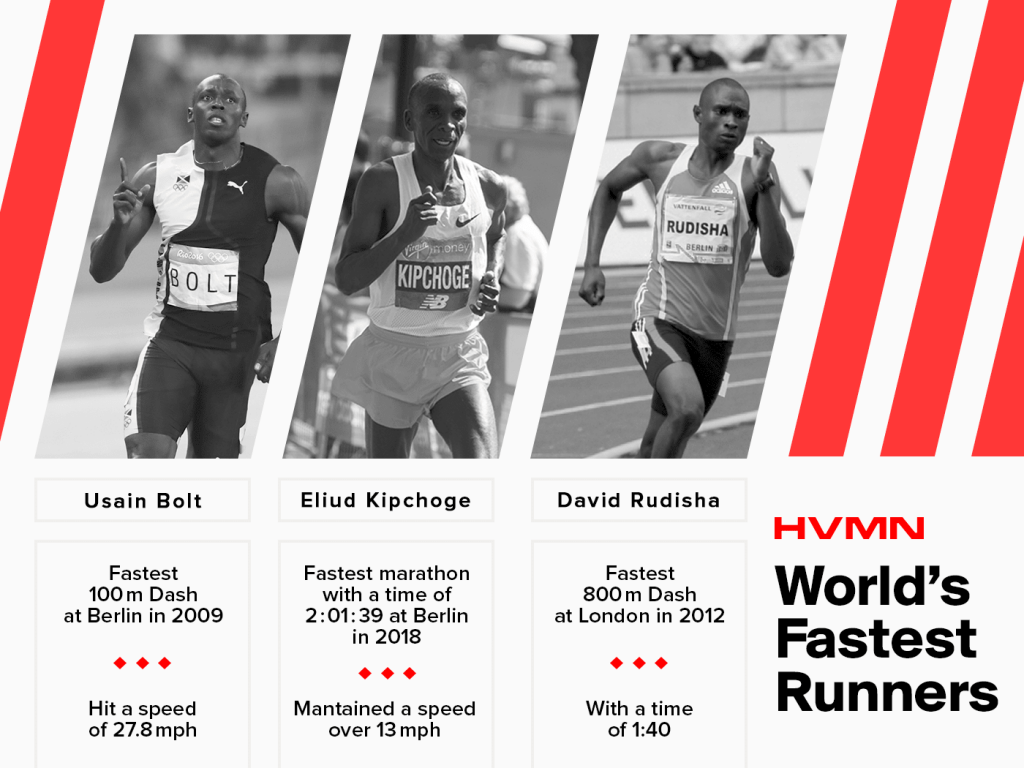
We are not Bolt or Kipchoge, but we share a desire to run faster – whatever that may mean to you.
Mental Techniques
Running faster is something that must be achieved through physical ability, but now more than ever, the mental aspect of endurance exercise is being considered a powerful tool to push the body to extreme lengths.
Welcome the Pain
Embracing pain is a way that runners can push themselves to log miles every day. The same is true for running faster. There’s an element of discomfort that must be welcomed in order to increase pace.
Try not to see it as pain, just an intense sensation like spicy food or dark chocolate.
– Michael Brandt, HVMN Co-founder and COO
This is especially difficult for
runners who are just starting because they’re not used to the feeling of pain.
During workouts like speed training, the pain will come – it’s about being
ready for it, anticipating it, and eventually, embracing it.
The pain will lessen with training. Crossing the lactate threshold is the point at which the body
cannot recycle the lactic acid accumulated in the blood, so it begins sending
pain and nausea signals in an effort to make you slow down and recycle all that
lactic acid. But you can train to increase that lactic threshold and decrease
the pain.
With training also comes a knowledge of your body and an understanding of pain –
remembering how it feels and at what point in the run it’ll hit.
The negativity is going to come, the disempowering thoughts are going to come because you’re pushing your body. You don’t have to believe them.
– Cindra Kamphoff
Positive Thinking
The ability to harness the connection between body and mind may lead to better
results. Awareness of your thinking, and how those thoughts make you feel, can
have a positive or negative impact on performance outputs. Sometimes telling
yourself “you’re great” is the first step to actually making that happen.
One meta-analysis concluded the strategy of self-talk facilitates learning (so
it can also help training) and enhance performance.2 Since self-talk has an impact on
performance, it’s important to make that self-talk positive.
Cindra Kamphoff is a performance coach to professional athletes, executives and
championships teams from all over the USA. She says, “The negativity is going
to come, the disempowering thoughts are going to come because you’re pushing
your body. You don’t have to believe them.”
Chunking
Breaking a casual run or race into chunks can help – especially for longer runs. This technique can help by making the total mileage feel less daunting. For a marathon distance, a popular way to break it down is into two 10-mile runs (16km) and a 10km.
Even on a smaller scale, chunking can be similar to gamifying the run. If you’re running in a city, you might push yourself to the end of the block. Breaking down a run into smaller sections may help increase speed incrementally, which will likely lead to a better overall time.
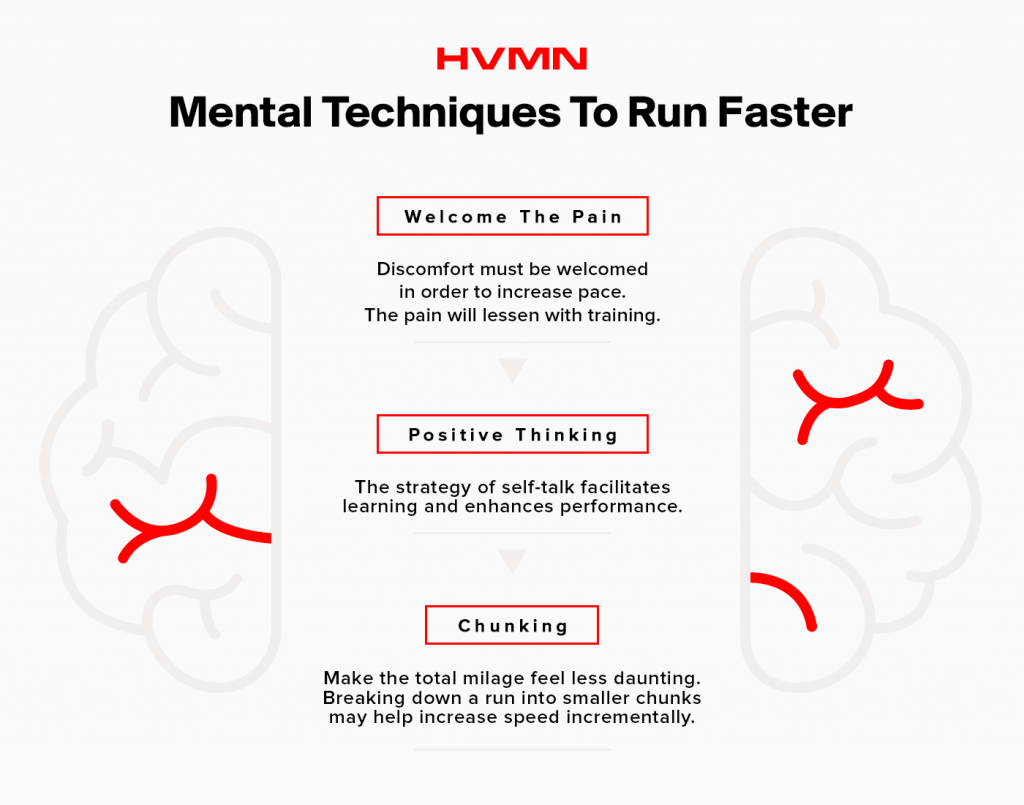
Training Smart
Training is like juggling. Breathing, form, power – all these things are on your mind with each stride. When one is dropped, the others tend to follow, but it’s during this training process that the best habits are built. Remember, it’s a process.
Running is about playing the long game. Think of it like a house. A good race or bad race is a single brick in the edifice of your long-term fitness.
– Sam Robinson
Things like intervals and tempo runs can help. It’s also important to track your progress: keep a training log to see how you’ve been able to increase speed after all that hard training.
Intervals
Intervals are great speed workouts for both the aerobic and anaerobic system.
They consist of short, high-intensity bursts followed by slow recovery phases
which are repeated one after the other. One of the earliest forms of interval
training was the Fartlek method (Swedish for “speed play”), and today, many
athletes use high-intensity interval training (HIIT). Sometimes, running fast
means actually running fast.
Generally, these workouts are ten seconds to several minutes long, run nearly
at maximum effort, followed by a rest period of up to four times the length of
the effort itself. The shorter the interval, the more of them you’ll likely do.
But the length of intervals (time and distance), power of those intervals, and
the rest period, should be optimized for the specific runner. Elite runners can
do four intervals of 10-minute runs at their 5k pace. Most runners won’t be
able to maintain that. An average interval workout is an 8×4: eight repeats of
a 400m run done in 90 seconds with a two-minute recovery.
One study in soccer players found that HIIT improved maximal aerobic speed.3 And recreational runners can
improve their running economy by replacing aspects of their conventional
training with long-interval running.4
Hills
Hill training usually targets power in the legs, meaning higher output.
One study found that six weeks of hill workouts increased top speed for runners, while also allowing them to sustain that speed 32% longer.5
Hill repeats are similar to interval training in that they’re usually conducted in short bursts. Warm up, then find a hill that’s about 100m long and run hard to the top, with the jog downhill serving as the recovery period. Start with two or four repeats, and work your way up to six or eight.
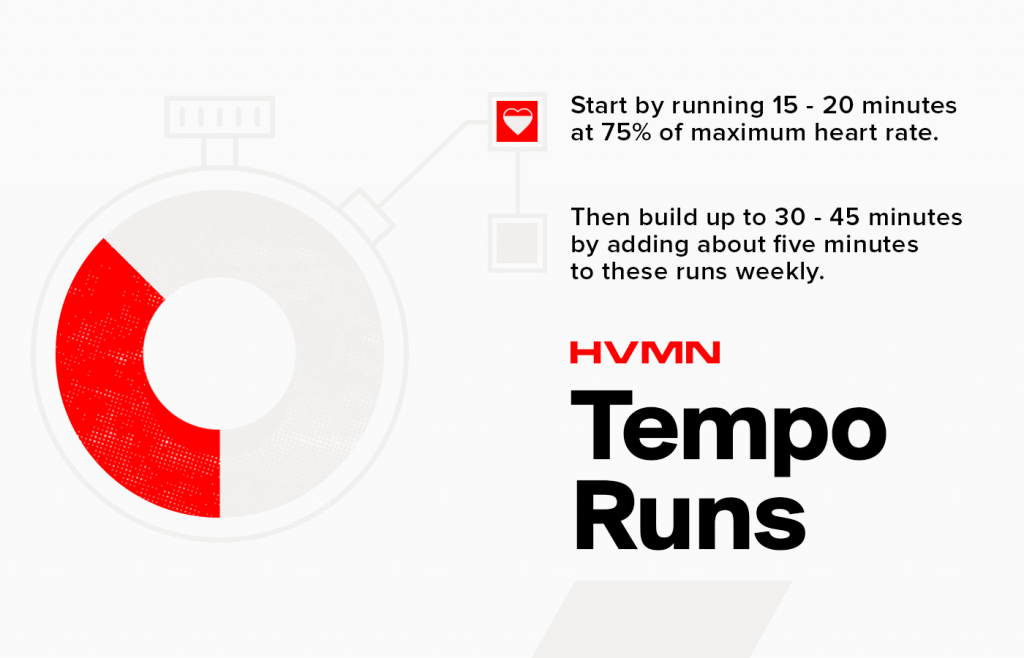
Tempo Runs
Tempo runs are also
known as lactate threshold runs – this is the point at which your body is
unable to recycle accumulated lactate in the blood. This is a pace that’s
anywhere between 10 and 30 seconds slower than a 5km or 10km pace.
The goal of tempo runs is to increase your anaerobic threshold, thus allowing
your body to sustain an effort that was previously unsustainable. This training
technique tends to benefit longer-distance runners more than sprinters.
Tempo runs should be part of a weekly running routine and can vary depending on
experience level and training needs. One way to incorporate this into training
is to start by running 15–20 minutes at 75% of maximum heart rate, then build
up to 30–45 minutes by adding about five minutes to these runs weekly.
Weight training can both improve strength and lead to greater running economy.
Strength Training
While many runners are laser-focused on logging miles, time in the gym can lead to time off your splits.6
Two areas of strength training are often employed by runners: leg and core workouts. Weight training can both improve strength and lead to greater running economy (as it did for female runners in this study).7
Exercises like lunges and squats can strengthen those leg muscles used more frequently on runs. For core workouts, even simple additions like planks and leg raises and weighted sit-ups can positively impact form and posture. On days where you’re looking for some active recovery, yoga is perfect for both developing strength in core muscle groups and stretching tight muscles.
Fix Your Form
Improving running form and technique can lead to faster speed. The way you run affects the way force is applied to your muscles and joints. Correcting form can be help injury prevention, as improper execution can cause injury if you’re a beginner;8 if you aren’t running, you aren’t getting faster.
In the endless chase for good overall form, it’s best to break it down into a few manageable techniques to consider on each run.
Stride Turnover
Changing stride turnover – how my steps taken during one minute of running – may
have an impact on speed.9
The goal is to have a higher stride turnover, meaning to take shorter, quicker
steps; these reduce the impact on your joints because you’ll hit the ground
with less force. Longer strides have the opposite effect, and can create more
impact because you’re in the air for longer. Sprinters will typically need to
lift their knees higher to achieve maximum leg power, but distance runners won’t
need as much lift.
Figuring out your stride turnover is easy. Just run for one minute at your 5km
pace and count the number of times your right foot hits the ground. To improve
stride turnover, jog for one minute to recover, trying to increase your stride
count by one. Repeat this several times with the goal of increasing strides
each time.
At the proper stride length, your feet should land directly under your body.
And when your foot strikes the ground, your knee should be slightly flexed,
bending naturally to the impact. Keep in mind that the middle of your foot should
be making contact with the ground, not your heel.
Heel Striking
While it’s very common very common,10 landing on your heel can mean too long of a
stride, which wastes energy and may cause running injuries (hello, shin
splints).11 Avoid landing on toes too, as this
can also increase fatigue and wear out your calves.
You want to be a mid-foot striker. Hitting the ground mid-foot allows you to
roll through to the front of your toes. Changing your footstrike takes
practice, but the results can show up both in speed and in reduced joint pain.
One study of runners from habitually barefoot populations showed an increase in
speed when mid-foot or front-foot striking.12
If you’re overstriding,
try increasing your number of strides. On your next run, focus on striking on
the balls of your feet. Interestingly, that’s where most people strike when
running barefoot; try running on grass (or another soft surface) without any
shoes on, translating that muscle memory to other runs. Running drills can help
– skipping, high knees, side shuffling, butt kicks – with all these, it’s
almost impossible to land on the heel.
Finally, keep those toes pointed in the direction you want to travel. As
fatigue sets in, form gets wonky and you may find your toes are turning in or
out, which can lead to joint pain.
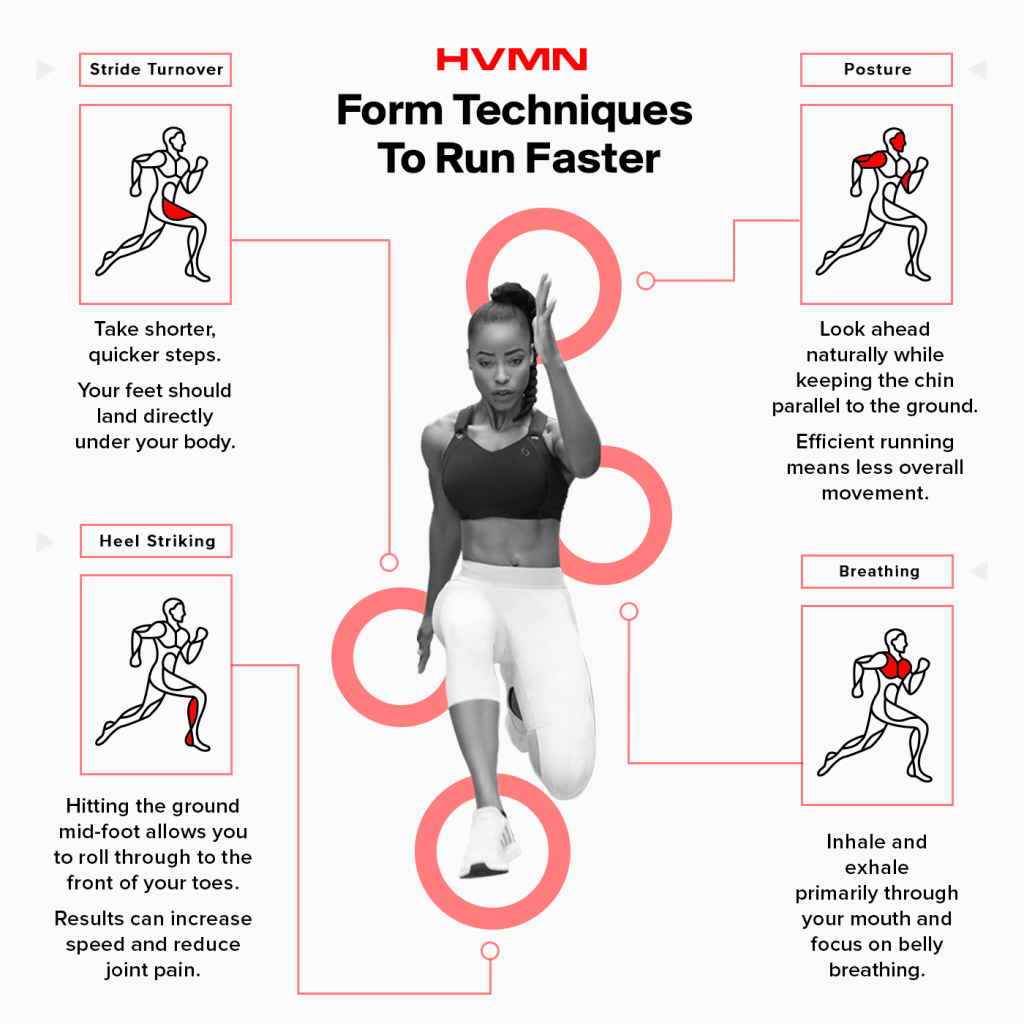
Posture
“Running tall” is a repeated mantra meant to encourage good running posture.
It starts with the head: look ahead naturally while keeping the chin parallel
to the ground, and avoid looking down at the feet. This should improve posture
in your neck, shoulders and back, which should be relaxed. Slouching during a
run? Try a deep, realigning breath and hold position. The torso and back should
be naturally straight, as this promotes optimal lung capacity and stride
length.
Avoid hiking up your shoulders, which can happen naturally with stress. Give
your shoulders a good shake to relax and keep them level.
Have your arms bent at a 90-degree angle, should swing back and forth around
the waist, powering the lower body. Think of yourself as two halves: left and
right, and keep each arm on that side of the body. Tension in the upper body is
controlled by the hands, so relaxed hands are also important. You may notice
tension developing as a run gets more difficult. Imagine you’re carrying an egg
in each hand and watch that tension disappear.
Breathing
Since oxygen feeds
your muscles, it’s important to understand how to take in the most air
possible.
Inhale and exhale primarily through your mouth – it’s the most effective way to
take in oxygen. Your nose can join the party too, but it can be difficult for
some to breathe through both simultaneously. Practice makes perfect here; you
can try it throughout the day to help get the body adapted to the technique.
Focus on belly breathing, with the force of the inhale extending to the
diaphragm with the stomach expanding. These should be deep, slow, rhythmic breaths.
Overall, you should see a decrease in cramps and an increased ability to pace
yourself.
Sleep & Recovery
The importance of rest cannot be understated, but it’s often forgotten or
unaccounted for in a training plan.“
Sleep and recovery days are
important to give tired muscles a chance to rebuild tissues that have been
broken down during exercise.13 That breakdown is meant to cause muscles to adapt and become stronger,
thus potentially leading to increased speed. Sleep is also part of this
process. Set a sleep schedule and get some screenless time before bed, because
screens may negatively impact rest.14 One study found that lack of sleep can lead to
muscle degradation.15
Recovery runs are
a must. These should be done at a slower, less-strenuous pace that allows the
body to recycle lactate as its produced. This pace per kilometre should be
about 40–60 seconds more than your average pace.
Consuming Your Way to Speed
What you eat can have an impact on how fast you run. A body operating on high-octane fuel will undoubtedly perform better than one with a less-optimised fuel source.
Diet
Diet can have a roundabout effect on speed through a few different avenues.
It directly impacts body composition, which affects speed. It can also determine the body’s fuel source, meaning that a diet low in carbohydrates can lead to fat-adaptation, allowing the body to tap into fat stores. If you aren’t a fat burner, carbs are essential to keep running pace, as glycogen depletion leads to bonking. And after a run, diet can help with recovery, enabling the body to train again faster.
VO2 max is a measure of one’s running fitness; it’s the maximum amount of oxygen that can be delivered to working muscle per unit of body mass. Those with higher VO2 maxes are better runners. And because body weight impacts VO2 max, the lighter the runner means a higher VO2 max which can mean a lighter runner is a better runner.
Many distance runners are employing the ketogenic diet for weight loss. The low-carb, high-fat diet can force a metabolic adaptation allowing the runner to burn fat as fuel (as opposed to carbs). And the restricting of carbohydrates often leads to better body composition.
Counting calories may help you lose weight. While the macronutrient composition of food can be more important than the amount of calories, counting calories while on keto might lead to greater results.
Supplements
Many runners drink coffee and consume carbohydrates before a race, giving the
body fuel sources to immediately tap into. Buffers are also useful, and may
delay the onset of muscle pain associated with the building up lactic acid in the blood (but really it’s the
proton associated with lactate) – check out sodium bicarbonate, beta-alanine
and HVMN Ketone. Ketones
are a fundamentally different fuel source from carbohydrates and fats that
cells normally use for energy.
Taken before or during exercise, D-BHB (used in HVMN Ketone) is 28% more efficient than
carbohydrates alone, helping your body do more work with the same amount of
oxygen.16 In one study, cyclists went ~2%
further in a 30-minute time trial.17
When taken with carbs, the glycogen-sparing effect of HVMN Ketone helps many
runners – the body will preferentially use the ketones as fuel first, saving
glycogen for later in the race, when the need it most.
Running Fast: a Personal Pursuit
If you want to improve, if you want to get faster, then you should expect to work to get there. Aspire to some of the world’s best runners and use that as motivation each time you lace up your shoes to run.
Sam Robinson is a writer and marathoner who has been featured in Outside magazine. Hear more about his running philosophy on the HVMN Podcast.
HVMN is an American company that manufactures and sells a ketone ester drink and nootropics products.
See full text of the original article here.
Scientific Citations


